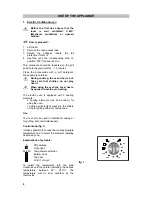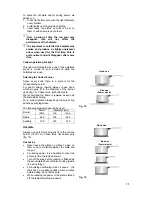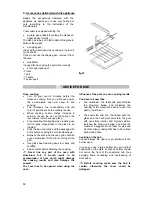
20
CHANGE OF GAS
Your cooker is foreseen to work with natural
gas, propane or butane. It is not foreseen for
butane or propane air.
For changing the gas type it is necessary to:
•
replace the nozzles (hob);
•
adjust the minimum level;
•
check the gas connection.
Stick the label delivered with the
appliance (spare nozzles, corresponding to
the type of gas used).
SPECIFICATION NOZZLES NO. 2
(Cat : II
2E+ 3+
) ,
(Cat : II
2H 3B/P
)
Cons.
Burner
Normal
power
(Kw)
Reduced
power
(Kw)
By-pass
(mm)
Gas type
Pressure
(mbar)
Nozzle
diameter
(mm)
g/h
m
3
/h
RAPID
2,60
0,72
0,42
Natural gas G20
Butane G30
Propane G31
20
28-30
37
1,12
0,86
0,86
188,8
-
-
-
0,248
AUXILIARY
1,00
0,35
0,29
Natural gas G20
Butane G30
Propane G31
20
28-30
37
0,70
0,50
0,50
72,6
-
-
-
0,093
Replacement of the nozzles
Every appliance has spare nozzles for every
gas. The whole of every nozzle is marked in
microns on the nozzle.
For changing the nozzles:
1. Remove the pan support;
2. Remove the burners;
3. Using a socket spanner 7 unscrew the
nozzles (fig. 26) and replace them with
those required for the type of gas in use
(see table no. 2).
4. Put in place the burners and the pan
supports.
Adjustment of minimum level of plate
burners.
When changing the gas type watch that the
minimum level be correct. A regular flame at
minimum level is about 4 mm; check that,
turning quickly the knob from the maximum to
the minimum position, the burner doesn’t go out.
Flame adjustment
1. Light the burner
2. Turn the knob to minimum level
3. Pull out the knob
4. Unscrew or screw the pin (on the right of tap
axle, fig. 27) until a regular small flame is
obtained. For butane-propane gas, screw
totally the pin clockwise
5. Put in place the knob
6. Turn the knob several times from maximum
to minimum level for verifying the flame
steadiness.
fig. 26
fig. 27















